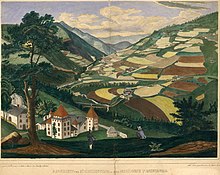3D




 [DEUTSCH]
[DEUTSCH]
Fischburg

Fischburg in Gröden - Südtirol. Beschriftung: „Ansicht von St. Christina und dem Schlosse Fischburg im Thale Groeden. In Oel gem. v. Ioh. Mosmair, und zu haben in dessen Cur. Handlg. in Botzen - Auf Stein gezeichnet von Ioh. Mart. Benz“
Die Fischburg ist eine Burg des 17. Jahrhunderts in Wolkenstein in Gröden (Südtirol, Italien).
Lage
Die Burg erhebt sich in der Gemeinde Wolkenstein in Gröden an der linken Talseite des Grödner Baches, gehört jedoch zur Pfarre St. Christina in Gröden. In unmittelbarer Nähe führt die FIS-Abfahrt Saslong vorbei.
Geschichte
Die Burg wurde von Engelhard Dietrich Graf zu Wolkenstein (* 1566, † 1647) erbaut und war Sitz des Gerichts Wolkenstein bis zum Ende des 18. Jahrhunderts. Die Lage der Burg inmitten zahlreicher Fischweiher, die laut Bericht von 1615 von Marx Sittich von Wolkenstein von dessen Bruder angelegt wurden, führte zur Benennung 'Fischburg'. Graf Engelhard Dietrich konzipierte die Burg eigentlich als Wehrburg gegen die Venezianer, wurde allerdings in diesem Vorhaben nicht unterstützt. Der Versuch, die privaten Interessen mit den Reichsinteressen zu verknüpfen, gelang darum nicht.
Die Inventare der Burg sind historisch reichlich dokumentiert. Man ersieht aus ihnen, dass die Burg stärker mit Jagdwaffen als mit Kriegswaffen bestückt war. Es waren auch viele Geräte zur Fischerei vorhanden.
Das Schloss verfiel infolge der Einbrüche der Franzosen am Ende des 18. Jahrhunderts, 1826 ließ die Familie Wolkenstein einen Großteil des Inventars versteigern. 1841 wurde die Burg den Gemeinden Wolkenstein und St. Christina geschenkt, die die Burg an die Armen vergaben und den totalen Verfall der Baulichkeiten herbeiführten.
1926 wurde die Fischburg an Baron Carlo Franchetti aus Venedig verkauft. Er stellte die Burg außen und innen mit in Südtirol und in Gröden erworbenen Einrichtungen, darunter Täfelungen, Öfen und viel Mobiliar, wieder her. Die Burg ist noch im Besitz der venezianischen Adelsfamilie.
Anlage
Die Planung ist auf den Bauherrn zurückzuführen, wobei ihm jedoch der Brixner Architekt und Künstler Hans Reichle und ein 1625 anwesender Festungsingenieur („Barthariamaister“) zur Hand gingen.
 [ITALIANO]
[ITALIANO]
Castel Gardena
Origine del nome
Il nome originario del castello, "Fischburg", significa "castello della pesca". Il nome deriva dai tanti laghetti che il proprietario del castello aveva fatto scavare per allevare delle trote.
Cenni storici
Il castello fu costruito nel 1641 dai Conti di Wolkenstein verosimilmente con l'intervento progettuale nel 1625 dello scultore-architetto Hans Reichle del Schongau, allievo del Gianbologna, allo scopo abitativo e come castello da caccia in stile rinascimentale, pur mostrando alcune caratteristiche di fortificazione. Il nome tedesco Fischburg deriva dal fatto che il conte aveva costruito nei paraggi una serie di laghetti nei quali allevava le trote che si dilettava a pescare. Il castello è situato a ridosso del pendio boschivo sul quale sono tracciati gli impinati sciistici Saslong di Selva e di Santa Cristina.
Il castello appartiene attualmente alla famiglia del Barone Andrea Franchetti, che lo abita nel periodo estivo. Per questo motivo il castello non è visitabile, seppur d'estate in occasione delValgardenamusika, si tengano dei concerti nel suo cortile

Il Castel Gardena con il paese di Santa Cristina sullo sfondo in una stampa di Johann Mosmair, disegno di Johann Martin Benz del 1840 ca.
 [ENGLISH]
[ENGLISH]

|
Castel Gardena ("Fischburg"), which straddles the territorial boundary between Selva Gardena and S. Cristina, was built as a summer castle and hunting lodge. Although Renaissance in style, its massive proportions are more reminiscent of the medieval art of fortification. The castle is not open to the public, but it is still worth the walk to see the building from the outside
|
Fischburg

Fish Castle in Val Gardena - South Tyrol. Caption: "View of St. Christina and the castle in the valley Fischburg Val Gardena. In accordance with oil. v. John xiv. Mosmair, and to have the cure. Handlg. in Bolzano - drawn on stone by John i. Mart. Benz "
The Fischburg is a castle of the 17th Century in Selva Val Gardena (South Tyrol, Italy).
Location
The castle stands in the town of Selva di Val Gardena on the left side of the valley of the river Gardena, however, belongs to the parish of St. Christina. In the immediate vicinity lead the FIS downhill past Saslong.
Hystory
The castle was built by Engelhard Dietrich Count of Wolkenstein (* 1566, † 1647) and was the seat of the Court of Selva until the end of the 18th Century. The location of the castle amidst numerous fish ponds that were created according to the report of 1615 Marx parakeet from Wolkenstein by his brother, led to the designation of 'fish Castle'. Dietrich, Count Engelhard actually designed the castle as a fortress against the Venetians, was however not supported in this endeavor. Link to the trial, the private interests with the interests of the Empire managed to not care.
The inventories of the castle are documented historically abundant. We see from them that the castle was equipped with more rifles than with weapons. There were also many devices available for fishing.
The castle fell into disrepair following the collapse of the French at the end of the 18th Century, in 1826 left the family Selva auctioning a large part of the inventory. In 1841 the castle communities Selva and S. Cristina was given to the awarded the castle to the poor and the total collapse of buildings brought about.
In 1926, the Fish Castle to Baron Franchetti of Venice Carlo was sold. He placed the castle inside and out with in the South Tyrol and Val Gardena acquired facilities, including paneling, furniture, stoves and much more, to restore. The castle is still owned by the noble Venetian family.
Plan
The plan is due to the client, with him, however, the architect and artist Hans Reichle Brixner and a military engineer was present in 1625 ("Barthariamaister") were on hand.